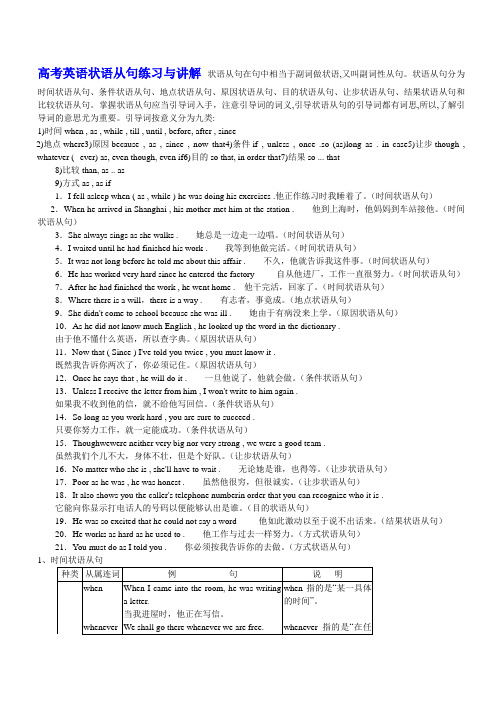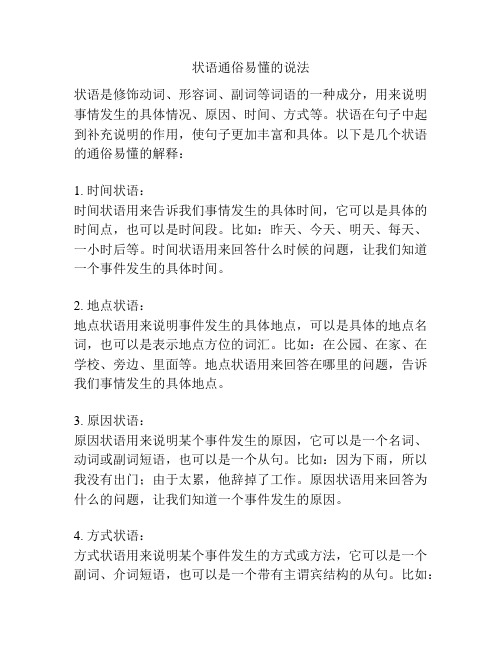状语的具体讲解(十)方式状语
(完整版)状语从句的讲解最全的状语从句讲解

状语从句的讲解就是用一句话作状语分为:时间,地点,方式,原因,结果,条件,让步,目的,比较一、时间状语从句第一次见到你一见到你我就喜欢上了你直到见到你五岁时见到你When, as, while, before, after, since, till/until, as soon as no sooner…than…scarcely…when…hardly…when… the minute the second the instant the moment by the time 截止 immediately instantly directlyeach time every time next time the first time on doing sthwhenwhile 当…时as1。
when 1)当…时/ 延续性动词短暂性动词都可用2)这时/3)届时、到时I was watching TV when my cellphone suddenly rang这时When I was five years old I could speak five languagesThe wet weather will continue tommorow when a cold front is expected to arrive届时到时注意:时间状语从句中动作发生有前后时先发生的用过去完成时When my mother came back I had already gone to bed.2。
while 1)从句动词延续性2)同时发生3)对比的意味“然而”4)趁着He taught himself while he worked in a bank 延续性动词当他在银行上班时While we were working they were having a rest.对比While they were having a discussion , they got very confused。
分析三大状语的用法,并给出10个例子。

分析三大状语的用法,并给出10个例子。
分析三大状语的用法并给出10个例子
1. 地点状语
地点状语用来表达一个事件或行为发生的地点。
下面是一些地
点状语的例子:
- 在学校:我在学校里见到了我的朋友。
- 在家里:昨晚我在家里看了一部电影。
- 在公园:他们在公园里玩得很开心。
2. 时间状语
时间状语用来表示一个事件或行为发生的时间。
以下是一些时
间状语的例子:
- 昨天:我昨天去了购物中心。
- 每天:我每天都锻炼身体。
- 上个周末:我们上个周末一起去了海滩。
3. 方式状语
方式状语用来描述一个事件或行为发生的方式或方式。
以下是
一些方式状语的例子:
- 快速地:她快速地跑到超市。
- 安静地:他安静地做了十分钟的冥想。
- 用努力:我用努力研究了一门新的技能。
这些是地点、时间和方式状语的一些例子。
通过使用不同类型
的状语,我们可以丰富我们的写作,并更准确地传达我们的意思。
请记住,状语应与句子的其他部分保持一致,并在语法上正确使用。
这是地点、时间和方式状语的一些例子。
通过使用不同类型的
状语,我们可以丰富我们的写作,并更准确地传达我们的意思。
请
记住,状语应与句子的其他部分保持一致,并在语法上正确使用。
英语什么是状语有哪些种类

英语什么是状语有哪些种类从功能语法的角度,英语状语的分类:环境状语,情态状语,连接状语,分别体现语言的三大元功能:概念功能,人际功能,语篇功能。
下面是店铺整理的英语什么是状语,欢迎阅读。
英语什么是状语就是动词的八个状态:时间、地点、原因、状态、目的、结果、方式、程度.修饰动词、形容词、副词以及全句的句子成份叫状语。
例如:My parents often tell us about their bitter life in the past.我父母经常给我们讲他们过去的苦难生活。
She studies hard.她努力学习。
I am very tired.我非常疲倦。
英语状语有哪些种类英语中的状语按其用途,可以分为时间状语、地点状语、方面状语、原因状语、结果状语、目的状语、条件状语、让步状语、程度状语、方式状语、伴随状语等11种。
一、时间状语She is to be married next month. 她预定在下个月结婚。
I’ll meet you at 4 o’clock. 我将在4点钟和你见面。
A lot of students missed my lecture yesterday. 昨天许多学生误了我的课。
二、地点状语He lives over the mountain. 他住在山的那一边。
I first met him in Paris. 我初次见到他是在巴黎。
The children are swimming in the river. 孩子们正在河里游泳。
注:地点状语除表位置外,还可以表“出发”“去向”“距离”等。
如:Are you glad to be going back to school? 返回学校你感到高兴吗?They lived many miles from the town. 他们住的地方离镇子好几英里远。
三、方面状语She is very weak in physics. 她物理很不行。
状语的具体讲解十方式状语

状语的具体讲解十方式状语Document serial number【UU89WT-UU98YT-UU8CB-UUUT-UUT108】句子成分之——-状语的具体讲解(十)方式状语具体用法:方式状语导读:方式状语,描述动作、事件或情况发生及存在的方式。
其表达方式通常有:1. 方式副词(介绍了常用副词)2. 介词短语(区分了 by,through, in, with四个表方式的介词用法)3. 形容词短语4. 方式状语从句(1)as if/as though(2)as/like (just) as…so…表示“正如”、“像……”。
(3)(in) the way (that) 引导的方式状语从句“以…方式”(一)方式副词,用来回答how 提出的问题。
常见的此类副词主要有: angrily 生气地 anxiously 焦急地 badly 糟糕地calmly 冷静地 carefully 仔细地 carelessly 粗心地 clearly 清晰地 closely 紧密地 dangerously 危险地 eagerly 热心地 effectively 有效地 faithfully 忠诚地 firmly 坚定地 happily 高兴地 nervously 紧张地suddenly 突然地 thoroughly 完全地 uncomfortably 不舒适地well 很好地 widely 广泛地 willingly 情愿地方式副词,等于介词短语“in a +形容词+ way”。
例如:angrily 等于in an angry waySome Internet words are widely used and spread.有些网络语言被广泛地使用和传播。
Volunteers always help others eagerly.志愿者们总是热心地帮助他人。
Can you speak it clearly你能清楚地讲一下它吗A dog came out from behind the door suddenly.一只狗突然从门后跑了出来。
状语的具体讲解(十)方式状语

状语的具体讲解(十):方式状语状语是指修饰谓语动词的成分,常表示时间、地点、原因、方式等。
在句子中起到连接的作用,使得句子更加完整、具有表达能力。
具体来说,方式状语是在句子中表示动作或情况发生的方式和方式的副词或者短语。
下面就让我们一起来具体了解一下方式状语的使用方法和注意事项。
方式状语的形式方式状语可以用副词,介词短语或者从句等形式表达,其位置通常在谓语动词之后,但如果是表示强调的话则可以放在句首或句末。
示例1.副词:他轻轻地关上了房门。
2.介词短语:他用手指轻敲了一下桌子上的纸张。
3.从句:她忙得连喝水的时间都没有。
功能和作用方式状语的主要功能是描述谓语动作或事件发生的方式,为句子提供细节和情境描写,使得句子更加丰富多彩。
通常与动词的语气和语调呼应,让句子产生更加生动的感觉,增加话语的表达力。
示例1.他轻轻地关上了房门。
——描述动作的轻柔、缓慢,表达语者对这个动作的细腻敏感的感受。
2.她用手指轻敲了一下桌子上的纸张。
——描述动作的细微,表达对于工作中需要细致耐心的态度。
3.她忙得连喝水的时间都没有。
——描述事件的紧张、忙碌,表达对于事务繁忙的感受和状态。
注意事项•不同的方式状语需要根据情况使用不同的语法形式,注意前后顺序及其关系,以免破坏句子的结构和流畅性。
•在使用多个方式状语时,需要注意语法的并列和从属关系,以避免歧义和意义模糊。
•在语句中使用方式状语需要考虑语境和句子的语义关系,避免翻译错误,语言不够自然。
方式状语是英文句子中非常重要的一种语法结构,可以为动词的行为和事件提供更加细致和具体的描绘。
如何正确使用方式状语,对于英文学习者来说是非常重要的一项技能。
希望本文提供的相关知识和技巧,能够为各位学习者提供帮助,更好地学习和运用英文语言。
高中状语知识点总结

高中状语知识点总结一、状语的分类状语可以分为时间状语、地点状语、方式状语、原因状语、结果状语、条件状语、目的状语等几种类型。
每种类型的状语在句子中的位置和使用方式都有所不同。
1. 时间状语时间状语用来表示动作或状态发生的时间,常见的时间状语包括:now, then, before, after, soon, since, until, while, when, etc. 在句子中,时间状语通常出现在动词的前面或后面,用来说明动作发生的时间点或时间段。
例如:She went to bed after she finished her homework.(她写完作业后就去睡觉了。
)2. 地点状语地点状语用来表示动作或状态发生的地点,常见的地点状语包括:here, there, everywhere, nowhere, in, out, up, down, etc. 在句子中,地点状语通常出现在动词的前面或后面,用来说明动作发生的地点或区域。
例如:They are playing basketball in the playground.(他们在操场上打篮球。
)3. 方式状语方式状语用来表示动作的方式或方式,常见的方式状语包括:slowly, quickly, carefully, well, badly, easily, etc. 在句子中,方式状语通常出现在动词的后面,用来说明动作的方式或方式。
例如:He drives carefully on the snowy road.(他在雪地上小心地开车。
)4. 原因状语原因状语用来表示导致某个动作或状态的原因,常见的原因状语包括:because, since, as, as a result of, due to, etc. 在句子中,原因状语通常出现在句子的开头或中间,用来说明动作或状态的原因。
例如:As it was raining, we stayed at home.(因为下雨,我们呆在了家里。
高中英语状语从句详细讲解及例句

高考英语状语从句练习与讲解状语从句在句中相当于副词做状语,又叫副词性从句。
状语从句分为时间状语从句、条件状语从句、地点状语从句、原因状语从句、目的状语从句、让步状语从句、结果状语从句和比较状语从句。
掌握状语从句应当引导词入手,注意引导词的词义,引导状语从句的引导词都有词思,所以,了解引导词的意思尤为重要。
引导词按意义分为九类:1)时间when , as , while , till , until , before, after , since2)地点where3)原因because , as , since , now that4)条件if , unless , once .so (as)long as . in case5)让步though , whatever (--ever) as, even though, even if6)目的so that, in order that7)结果so ... that8)比较than, as .. as9)方式as , as if1.I fell asleep when ( as , while ) he was doing his exercises .他正作练习时我睡着了。
(时间状语从句)2.When he arrived in Shanghai , his mother met him at the station .他到上海时,他妈妈到车站接他。
(时间状语从句)3.She always sings as she walks .她总是一边走一边唱。
(时间状语从句)4.I waited until he had finished his work .我等到他做完活。
(时间状语从句)5.It was not long before he told me about this affair .不久,他就告诉我这件事。
(时间状语从句)6.He has worked very hard since he entered the factory 自从他进厂,工作一直很努力。
状语通俗易懂的说法

状语通俗易懂的说法状语是修饰动词、形容词、副词等词语的一种成分,用来说明事情发生的具体情况、原因、时间、方式等。
状语在句子中起到补充说明的作用,使句子更加丰富和具体。
以下是几个状语的通俗易懂的解释:1. 时间状语:时间状语用来告诉我们事情发生的具体时间,它可以是具体的时间点,也可以是时间段。
比如:昨天、今天、明天、每天、一小时后等。
时间状语用来回答什么时候的问题,让我们知道一个事件发生的具体时间。
2. 地点状语:地点状语用来说明事件发生的具体地点,可以是具体的地点名词,也可以是表示地点方位的词汇。
比如:在公园、在家、在学校、旁边、里面等。
地点状语用来回答在哪里的问题,告诉我们事情发生的具体地点。
3. 原因状语:原因状语用来说明某个事件发生的原因,它可以是一个名词、动词或副词短语,也可以是一个从句。
比如:因为下雨,所以我没有出门;由于太累,他辞掉了工作。
原因状语用来回答为什么的问题,让我们知道一个事件发生的原因。
4. 方式状语:方式状语用来说明某个事件发生的方式或方法,它可以是一个副词、介词短语,也可以是一个带有主谓宾结构的从句。
比如:悄悄地走过去、用手机拍照、以身作则地带头等。
方式状语用来回答怎么样的问题,让我们知道一个事件是以怎样的方式发生的。
5. 程度状语:程度状语用来修饰形容词、副词,表示程度的大小。
它可以是一个副词、介词短语,也可以是一个带有主谓宾结构的从句。
比如:非常快、非常重要、有点累、非常认真地学习等。
程度状语用来回答到什么程度的问题,让我们知道某个事物、行为的程度有多大。
综上所述,状语在句子中起到补充说明的作用,通过描述具体的时间、地点、原因、方式和程度等,让我们更加清楚地理解一个事件发生的情况。
使用状语可以使句子更加丰富和明确,让读者或听者更好地理解和把握文章的含义。
- 1、下载文档前请自行甄别文档内容的完整性,平台不提供额外的编辑、内容补充、找答案等附加服务。
- 2、"仅部分预览"的文档,不可在线预览部分如存在完整性等问题,可反馈申请退款(可完整预览的文档不适用该条件!)。
- 3、如文档侵犯您的权益,请联系客服反馈,我们会尽快为您处理(人工客服工作时间:9:00-18:30)。
句子成分之——-状语的具体讲解(十)方式状语
具体用法:方式状语
导读:方式状语,描述动作、事件或情况发生及存在的方式。
其表达方式通常有:
1. 方式副词(介绍了常用副词)
2. 介词短语(区分了by,through, in, with四个表方式的介词用法)
3. 形容词短语
4. 方式状语从句
(1)as if/as though
(2)as/like (just) as…so…表示“正如”、“像……”。
(3)(in) the way (that) 引导的方式状语从句“以…方式”
(一)方式副词,用来回答how 提出的问题。
常见的此类副词主要有:angrily 生气地anxiously 焦急地badly 糟糕地
calmly 冷静地carefully 仔细地carelessly 粗心地
clearly 清晰地closely 紧密地dangerously 危险地
eagerly 热心地effectively 有效地faithfully 忠诚地
firmly 坚定地happily 高兴地nervously 紧张地
suddenly 突然地thoroughly 完全地uncomfortably 不舒适地
well 很好地widely 广泛地willingly 情愿地
方式副词,等于介词短语“in a +形容词+ way”。
例如:angrily 等于in an angry way
Some Internet words are widely used and spread.有些网络语言被广泛地使用和传播。
Volunteers always help others eagerly.志愿者们总是热心地帮助他人。
Can you speak it clearly?你能清楚地讲一下它吗?
A dog came out from behind the door suddenly.一只狗突然从门后跑了出来。
(二)介词短语,常见的有:in, by...,with..., through...等。
1. by的用法
(1)by+n/动词ing 表示“通过……方式”
The blind learn something by touching.
盲人通过触摸学习东西。
We get more information by reading newspaper.
通过阅读报纸,我们得到更多消息。
(2)by+交通工具表示“搭乘……”
e.g by bus、by ship乘船、by taxi、by train搭火车、by plane搭飞机(3)by+水陆空状态词也表示交通方式,如:
by road 公路运输;乘汽车/by land 陆地运输
by sea 海路运输;乘船/by water 水路运输;乘船
by air 航空运输;搭飞机
(4)by+通讯方式表示“用…作为联系方式”
by letter 书信联系;以书信的方式
by express 快递
by e-mail 邮件联系
by phone 打电话;电话联系
by fax 传真
(5).by固定搭配
by hand 手工制作;用手
2.in的用法
(1)in+语言表示“用…语言”
例:in Chinese 用中文
in French 用法语
How do you spell your name in English?
你的名字用英语怎么拼?
How to say “hello”in Spanish?
怎样用西班牙语说“你好”?
(2)in+材料表示“用…材料”
in ink
(3)in+形容词/物主代词/名词所属格+way“以…方法”
in a traditional way 以传统的方式
in his way 以他的方式
in Paul’s way 以保尔的方式
3. with 的用法
with+具体的工具或五官表示“用……”
例:eat with a spoon 用勺子吃
write with a pencil 用铅笔写
cut with a knife 用刀子切
We see with our eyes, and hear with our ears. 我们用眼睛看,用耳朵听。
4. through 的用法
through:表示“以;通过;经由”。
如:
He succeeded through hard work.
可以用by替换
例句:
He behaves in a respectful way. 他举止彬彬有礼。
She smiled in a friendly way. 她友好地笑了笑。
By using his hybrid rice, farmers are producing harvests twice as large as before. 通过使用他的杂交水稻,农民的产量是以前的两倍大。
They also express their feelings by using unspoken language through keeping physical distance, actions or posture. 他们还通过使用无声的语言,及通过保持身体的距离,动作或姿势,来表达感情。
He must be able to use the foreign language through forgetting all about his own. 他必须能够通过忘记自己的语言来使用外语。
I finished the essay through her help. 我借助她的帮助完成了这篇文章。
(三)形容词(短语),表示谓语动词发生的方式或状况。
The hare was caught alive. 兔子被活捉了。
(表示被捉时的状况或方式)
He went to bed cold and hungry. 他又冷又饿地上床睡了。
(表示方式或伴随)The child was lying in bed awake. 孩子醒着躺在床上。
(表示方式或伴随)
He spent the entire journey asleep. 他在睡觉的状态下度过了整个旅程。
(表示方式或伴随)
(四)方式状语从句
在复合句中作方式状语的从句称为方式状语从句。
方式状语从句一般位于句末,
有时位于句中。
方式状语从句通常由as if, as though, as, the way引导。
1. as if/as though 引导的方式状语从句:
The injured man acted as if nothing had happened to him. 这个受伤的男子行动起来好像什么都没发生似的。
The boss speaks aloud as though he is angry. 老板大声说着话像是生气了。
2. as/like (just) as…so…引导的方式状语从句:表示“正如”、“像……”。
As water is to fish, so air is to man.
我们离不开空气,犹如鱼儿离不开水。
Will you please do the experiment as I am doing?
请按我做的方法做这个实验好吗?
Always do to the others as you would be done by.
你希望别人怎样待你,你就要怎样待别人。
You should do like/as I do.你应按我做的那样去做。
Do you make bread like/as you make cakes?
你做面包的方法是不是和你做点心的一样?
3.(in) the way (that) 引导的方式状语从句“以…方式”
the way可以用作连词,引导方式状语从句,相当于as。
She doesn't speak the way he does.她说话的方式与他不同。
I shall do the work the way my father did.我将像我父亲那样做这项工作。
